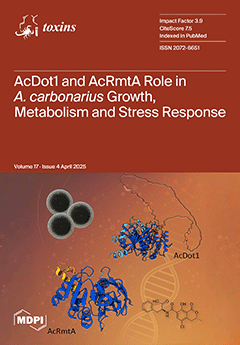Aflatoxin B
1 (AFB
1) is widely present in raw materials for food and feedstock, posing a significant threat to the health of humans and animals. This study explored the toxicokinetics of a single oral administration of AFB
1 at a dose of 100 µg·kg
−1 BW (body weight). Donkey blood samples were gathered at 0, 5, 10, 15, 20, 30, 45, and 60 min and at 1.5 h, 2 h, 2.5 h, 3 h, 3.5 h, 4 h, 4.5 h, 6 h, 9 h, 12 h, 24 h, 48 h, 72 h, 96 h, and 120 h through jugular vein sampling needles at intervals. Fecal and urinary samples were collected at 0 h and every 6 h thereafter until 120 h. The concentrations of AFB
1 and AFM
1 in plasma, urine, and feces were quantitatively analyzed using LC-MS/MS. The maximum concentrations of AFB
1 and AFM
1 in plasma were 13.10 ± 6.35 µg·L
−1 and 0.72 ± 0.33 µg·L
−1, occurring at 1.38 ± 0.89 h and 2.25 ± 1.57 h after oral administration, respectively. The AFB
1 and AFM
1 elimination half-lives (T
1/2Elim) were 6.65 ± 2.84 h and 5.85 ± 3.00 h, respectively. The total clearances (CL) of AFB
1 and AFM
1 were 163 ± 52.2 L·kg
−1 BW
−1·h
−1 and 3210 ± 2450 L·kg
−1 BW
−1·h
−1, and the volumes of distribution (Vd) for AFB
1 were 1440 ± 417 L·kg
−1·BW and 22,400 ± 14,800 L·kg
−1·BW, respectively. In addition, the total amounts of AFB
1 and AFM
1 excreted over 120 h through urine and feces accounted for 3.38 ± 0.92% and 3.44 ± 1.45% of the total intake, respectively (calculated by material mass). Furthermore, the research showed that the absorption and metabolism of AFB
1 were rapid in male donkeys, with the tissue exhibiting a wide distribution and long duration.
Full article






